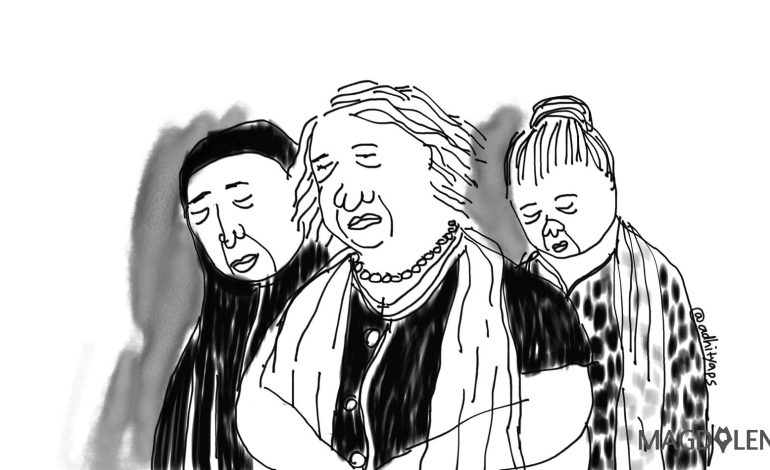Japan’s Aging Population Means More Elderly and Migrant Workers in Job Market
As Japan struggles with labor shortage caused by an aging population, it relies on senior citizens as well as migrant workers.

One quiet evening in downtown Tokyo, a woman about 77 years of age greeted my friend and me as we entered her bar for dinner. To get inside Tanabata, you have to go through a half-closed green curtain called noren, traditionally used at shops and restaurants in Japan, before opening the main door.
Hideko has run the traditional neighborhood bar located near the Higashi-koenji station for more than 38 years.
“May 26, 1981 I opened this bar,” she began her story told in Japanese while my friend interpreted for me, as she prepared a plate of Japanese fried rice.
At the time Japan had become a highly urbanized country. Tokyo was the epicenter of this transformation, with around 60 percent of its residents living in densely populated areas by early 1980s, She has witnessed more and more people came to Tokyo from various parts of Japan and also from outside the country.
“You are my first Indonesian customer,” she told me, before recalling the love story between Indonesia’s founding president Soekarno and his Japan-born Ratna Sari Dewi.
It is not easy to get to her bar; you cannot find information about it online. Our visit was made possible through a prior arrangement made by a friend who used to live nearby and was a regular customer. Like other neighborhood bars, it mainly serves people from the surrounding area. When we arrived, the two of us were her only customers.
These days, many new and franchise bars come and go in cities like Tokyo, offering modern interior and many seats to accommodate more customers. Often there is music playing in the background, sometimes even a live band. The interaction mainly happens among customers who come in their own group. But at Tanabata the customers often engage in conversation among themselves, or with the bar owner. Instead of music, there would only be a small TV showing some random program.
At the bar, Hideko is the owner, the chef and a “Mama” to all her customers. Her loyal customers are mainly people around her age, but there are also some younger customers who moved to or were born in the neighborhood after Tanabata opened. Mama is a sister, mother and grandmother to them. The relationship is almost like one big extended family.
At what may be retiring age in many societies, she continues to run the bar with her husband, Kenji, who is 83. In Japan, however, working in old age has increasingly become more common. Over the last few decades, the country has been dealing with significant demographic changes due to low birth rates and the ageing population.
With approximately 28 percent of its population over the age of 65, Japan’s aging rates is one of the fastest in the world, and old-age dependency ratio (OADR) stands out as the highest. OADR is an age population ratio of those typically not in the labor force (dependent part ages 0 to 14 and over 65) and those typically in the labor force (the productive part ages 15 to 64). It is used to measure the pressure on the productive population.
Moreover, Japan has been facing a subsequent increase in spending on social welfare such as health-care and pension, while the proportion of citizens in the labor force shrinks. In this situation, the country has been seeing more and more elderly people in work places, even after they turn to the age of official retirement.
Mama is one of them. She lives in high spirits and dignity. “Enjoy every present moment,” she said when asked how she maintained her health and kept being motivated in order to be productive and active at her age.
Labor Migration Issues
The demographic trends underline the urgency of labor migration intakes. With challenges of labor shortage, immigration has also become one of the solutions to Japan’s aging society, with Indonesia being one of the main contributing countries . According to data released in January 2020 by Japan’s Ministry of Health, Labor and Welfare (MHLW), over 1.6 million foreign nationals work in Japan officially, of which 51,337 were from Indonesia.
More than half of the Indonesians worked under the Technical Intern Training Program (TITP). There are also 338 Indonesian care workers and nurses working in Japan under the Indonesia-Japan Economic Partnership Agreement (IJEPA).
The TITP was created in 1993 with the purpose of international cooperation through the transfer of “Japan’s advanced skills” to developing countries through foreign trainees. Many argued that the benefit to Japan under this scheme was to secure low-paid labor. Meanwhile, the economic partnership agreement is a trade agreement, regulating labor migration under the IJEPA normalized Indonesian migrant workers as tradable commodities.
In December 2019, Indonesia’s Ministry of Manpower in cooperation with International Manpower Development Organization Japan (IM Japan), a Japanese public interest incorporated foundation appointed by Japan’s MHLW, agreed to continue deployment of Indonesian workers to Japan under the TITP, and increase the number of technical intern trainees by 5,000 per year. Indonesian ministry has been preparing new training facilities for the prospective migrant workers under the TITP.
However, the recruitment process of migrant workers to Japan in their countries of origin is rife with frauds and illicit practices. Overcharging is one of such practices that remains rampant. It is common for prospective Indonesian migrant workers to pay a staggering IDR 30 million to 90 million (approximately USD 2,200 to 6,600) during the recruitment processes.
By continuing this cooperation under TITP, Indonesian government has been indirectly facilitating the exploitation of workers migrating to Japan by continuing the partnership and by adding the quota to schemes such as this one. Exploitations and abuses are committed mainly by the private sector in collaboration with government officials who provide licenses to private agents without due assessments and inspections.
Systematic abuses and exploitations against migrant workers start from the recruitment process, and continues during preparation and training programs, deployment, into their work place in the destination country and also until after they return home.
The Indonesian government needs to impose a moratorium on such partnership and re-negotiate with the Japanese government in order to develop a joint program that equally respects and protects migrant workers’ rights, while truly benefitting both countries.
Perhaps then, bars like Mama’s Tanabata might see their customer bases widen to include more foreigners someday.













